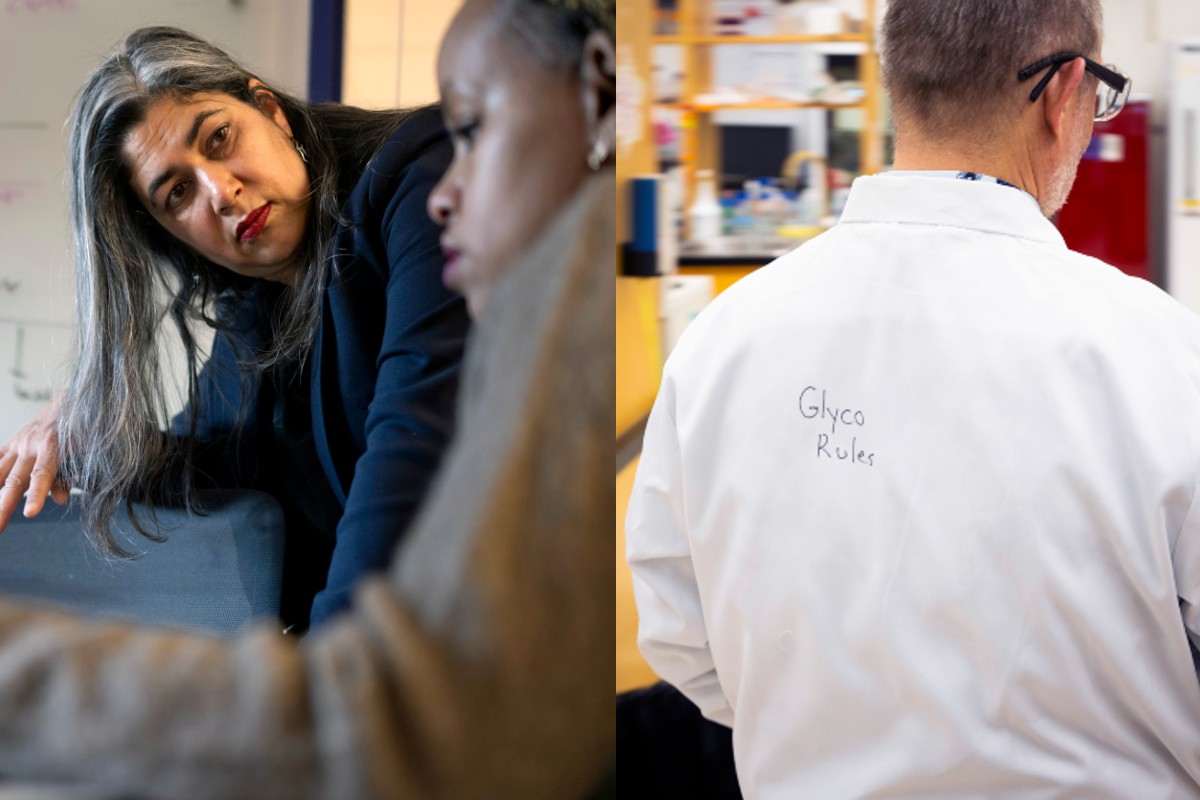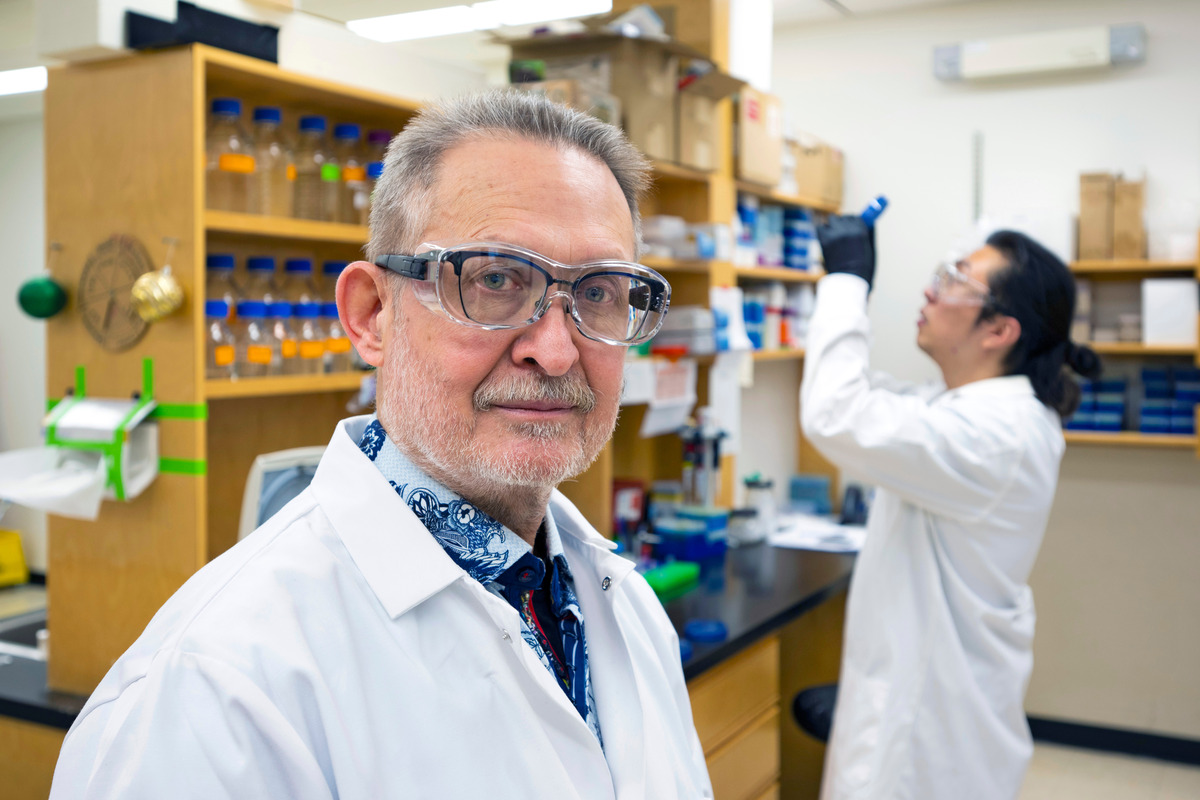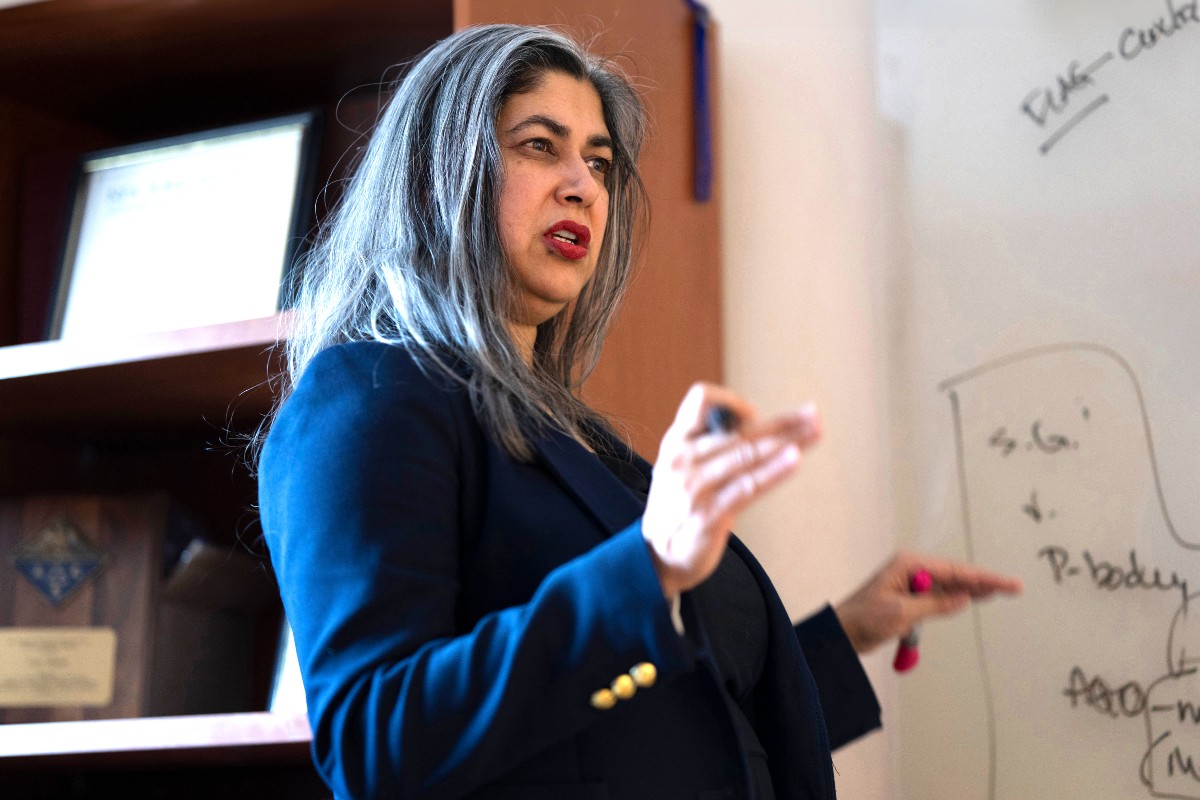
CERC and founder and director of the Glycomic Institute of Alberta Lara Mahal (left) works with a student in a classroom, explaining the science of glycomics. Warren Wakarchuk (right), scientific director of GlycoNet, is pictured in the lab wearing a lab coat that says "Glyco Rules." Photos: John Ulan
Sugars are one of life’s building blocks, influencing the expression of many facets of health and the course of disease. Chances are you know of someone with the neurodegenerative disease Alzheimer’s. Half a million Canadians have it or some other kind of dementia. But you might not know that specialized carbohydrates could have a role in the disease. A carbohydrate-binding receptor may influence the rate at which the tangled plaques, a hallmark of Alzheimer’s, form in the brain. It’s one of many life processes that glycobiologists are studying.
More trivially, if you’re a human of a certain age, you’ll know about wrinkles. Whether you spend your time smiling or frowning, or just maintain a poker face, there’s no avoiding wrinkles. But check out the beauty aisles at your local drugstore and you’ll find one of the hottest skin-plumping additives to face creams: hyaluronic acid, also a discovery of the field of glycoscience.
The field is wide-ranging, and it’s revolutionizing our understanding of how the human body works. It is revealing solutions to some of the most confounding questions we have about human health and disease processes.
Hyaluronic acid is a kind of glycan. Glycans are sugars, strings of saccharides that make up the most abundant class of biomolecules on Earth. Without them, many human cells would not be able to interact with one another and some biological processes simply would not happen.
The effect of glycans on our health starts at conception, when sperm meets egg and an embryo begins to take shape. Glycans influence the formation of our immune systems. Our blood types are differentiated thanks to glycans, meaning a life-saving blood transfusion for one person could be a death sentence for another, because of just one sugar molecule. Glycans answer the door when viruses come knocking, but each virus binds to a specific glycan, and the location of that glycan in your body can mean the resulting disease is more or less severe.
Much like the fields of genomics, proteomics and metabolomics before it, glycomics — the study of glycans — is putting another building block of life under the microscope, or more accurately, the microarray. (More on that later!) The goal is to identify, categorize, describe and understand how these sugars work in our bodies.
University of Alberta scientists are leading the way, using that new knowledge to save lives with breakthrough discoveries to treat cancer, skin diseases, transplantation and even neurodegenerative diseases like Alzheimer’s.
Group Effort Leads to Large Effects
Most of us understand that when we talk about “protein,” we might mean an egg we’re frying for breakfast or we might be referring to the large molecules inside our bodies that are required for our cells to work. Similarly, we tend to use the words “sugar,” “carbohydrate” and “glucose” interchangeably, to mean both our food and our molecules. “Glycan” is yet another synonym. In science parlance it refers to the specific class of molecules that decorate a wide variety of proteins and lipids. In the case of proteins, glycans are what’s known as post-translational modifications: they show up after the genetic instructions in DNA are transferred to mRNA and coded to make a protein. Glycans are like the finishing layer, thanks to a process called glycosylation.
“The glycans help fine-tune the biological function of proteins,” explains biochemist Warren Wakarchuk, who was recruited to the U of A in 2019 to become scientific director of GlycoNet, which leads Canada’s glycomics research efforts. That organization serves 190 researchers at 36 institutions across Canada, as well as international collaborations, providing critical support for research in the field of glycoscience.
“For a long time people thought these glycan decorations couldn’t be too critical for biology because they’re everywhere,” Wakarchuk says. “But it turns out they are central to all kinds of biological systems.”
Wakarchuk points out that a key technology to study glycans — mass spectrometry, which measures the mass-to-charge ratio of ions — has improved by leaps and bounds in recent years, leading to a better understanding of the many glycans humans produce. He expects the improvement to continue, much as technology has improved for genome sequencing.
“When I worked at the National Research Council, we had a project proposal to sequence an entire bacterial genome and the price tag was going to be $2.1 million and it was going to take two years,” Wakarchuk says. “That happens in an afternoon now and it costs $60.”
GlycoNet was awarded a grant from the Canada Foundation for Innovation’s Major Scientific Initiatives Fund starting in 2023 and is also an inaugural recipient of a grant from the new Strategic Science Fund from Innovation, Science and Economic Development Canada.
Wakarchuk says he accepted the GlycoNet position because it was an opportunity to continue the collaborative tradition of glycan research in Canada.
“The Canadian community, by nature of the people who populated it in the beginning, is quite collaborative,” he says. “Here was an opportunity for carbohydrate-specific projects of a translational, very applied nature that would capitalize on the network of carbohydrate scientists across the country.”
Since 2015 GlycoNet has funded more than 200 research projects and trained more than 600 new scientists. Trainees are now getting faculty positions at universities and taking carbohydrate science to the next level, he says. “And I think it’s important that it comes out of the University of Alberta.”
Headquartered at the University of Alberta, the organization also has integrated research facilities at seven institutions across the country to provide glycan analysis, carbohydrate synthesis and drug discovery.
“As a direct result of the success of GlycoNet, we have these established centres doing high-level glycomics analyses for everything from infectious diseases to neurological diseases,” Wakarchuk says. It’s a model that is being adopted by others in Europe and elsewhere.
“It’s nice to see that people recognize that geographically we have this huge country, but scientifically we’re a small group,” Wakarchuk says. “Thanks to this high level of expertise and co-operation, we are not just doing discovery science: We’re doing translational science in biology, medicine, even engineering. It crosses a lot of boundaries.”
Wakarchuk’s own research laboratory uses both synthetic biology and glycoscience to improve the way pharmaceutical companies make protein-based drugs so they are more effective. “We are getting science out of the laboratory and into the real world,” he says. “And that’s a good reason to get out of bed every day.”
A Sweet History
The fact that the U of A is the epicentre of glycan research in Canada and quickly taking its place as a world leader in the field is no accident. We can thank our collective “Sugar Daddy” for getting it all started. Ray Lemieux, ’43 BSc, ’91 DSc (Honorary), was an Alberta-born scholar who is one of the progenitors of glycoscience.
Lemieux was working at the National Research Council lab in Saskatoon in 1953 when he and a postdoctoral fellow (George Huber) were the first in the world to synthesize sucrose. Sucrose — table sugar — is a relatively simple molecule, but it was very hard to reproduce. In fact it’s been referred to as “the Mount Everest of organic chemistry.”
“Ray Lemieux literally had to invent the chemistry that was necessary to carry out those reactions,” says Wakarchuk.
Lemieux perfected techniques to produce sugar molecules and developed theories to understand their structures and interactions with proteins. Several of those techniques and ideas are still in use today. These include the halide-ion method, the anomeric effect, the concept of “key polar groups” on glycans and the importance of water in mediating the binding of glycans by proteins.
Thanks to Lemieux’s breakthrough, glycans could be synthesized and studied at a much deeper level, harnessing their power to improve human health. His discovery laid the groundwork for the development of antibiotics, vaccines, methods to overcome rejection in organ transplant, and treatments for hemophilia.
Lemieux returned to the U of A in 1961 to lead the university’s organic chemistry research, and it’s here that he did much of his most groundbreaking and creative work. He went on to synthesize all of the glycans that determine human blood groups. He launched Alberta’s biotechnology industry by founding companies such as Chembiomed Ltd., R&L Molecular Research and Raylo Chemicals. He was recognized with the Gairdner Foundation International Award in 1985 and the Albert Einstein World Award in Science in 1992, among a long list of accolades. His work helped inspire a generation of sugar scientists.
The Next Generation
“We’re trying to foster collaboration both within the university and outside it to educate people about the importance of glycomics, so that the work we do shines and brings it forward to the next generation of scientists,” says chemist Lara Mahal. She was recruited to the U of A as Canada Excellence Research Chair in Glycomics in 2019, a position that comes with $20 million in federal funding for her research, disbursed over seven years.
In addition to holding the chair, Mahal’s leadership in her field is evinced by the fact she is also the founding director of the Glycomics Institute of Alberta. The institute was launched at the U of A in 2022, building on Lemieux’s legacy. It communicates the importance of glycans to the public, educates students from high school to postdoctoral levels, and creates innovative research collaborations within and outside the university. In the effort to improve human health through glycoscience, the institute also serves to establish provincial expertise in this research area.
The Glycomics Institute of Alberta is a cross-campus effort that brings together dozens of basic scientists with experts from disparate medical fields such as oncology, neuroscience, organ transplantation and bioengineering. In fact, the institute’s associate director, Simonetta Sipione, is a neurobiologist in the Faculty of Medicine & Dentistry. The aim, Mahal says, is to create new partnerships and bring new perspectives that are leading to discoveries with immediate payoff for patients.
Part of the work of Mahal’s team at the institute is to engage the next generation of glycan scientists. Her team has developed teaching materials available for teachers to download and use in the classroom. The materials educate about these sugars, which include, for example, fucose, which helps cells recognize each other and communicate. When something goes wrong with fucose, cancer or inflammatory disorders may follow. Mahal hopes to improve the understanding of the “glycocode,” the information encoded in the structure of a glycan. One of her goals is to make sure that the average biochemistry student is as familiar with glycans as they are with amino acids.
Mahal fell in love with glycan research at the University of California, Berkeley while studying with Carolyn Bertozzi, who went on to win the 2022 Nobel Prize in Chemistry for developing chemical reactions that can be carried out inside a living organism without changing the normal chemistry of the cells. Those reactions are used in labs around the world to do things like trace biological changes in disease and improve the effectiveness of cancer drugs. Bertozzi developed her Nobel-winning process in order to study glycans.
“This was early in chemical glycobiology, when we were still trying to figure out how sugars really work,” Mahal recalls. She and her fellow glycan researchers wanted others in the scientific community to understand “the fact that sugars were important.”
“We needed high throughput research with lots of data that showed unequivocally that changes to the glycans in cancer, in immunology, in brain diseases, are not just indicative of the diseases but are actually part of the mechanism,” Mahal says.
There was a problem. The tool to demonstrate the disease-causing role of glycans just didn’t exist. So she devised one herself.
Sugars are slippery characters. Not only do they like to bind with water, proteins and fats, they are also hard to differentiate from each other. Mass spectrometry can accurately detect the mass of molecules in order to tell them apart, but many sugars have identical mass. Mahal found it laborious to analyze the sugars on a single protein, one at a time, when her goal was to compare samples from a hundred cancer and a hundred non-cancer patients all at once to look for patterns.
“It was just too time-consuming to make it usable, so I thought, ‘How can we get this kind of data in a simpler way? Instead of looking at them one by one, what if we could make an array and look at all of the differences simultaneously?’ ”
The solution Mahal’s lab developed was to bind the glycans with common proteins called lectins in a microarray that compares dozens of samples at once. The lab of a Japanese researcher (Jun Hirabayashi) came up with a similar idea a few months later and both labs are credited with inventing the lectin microarray, which is now in use in Europe, the United States, Japan and, of course, in Mahal’s laboratory at the U of A.
Mahal has numerous collaborative projects underway that have already changed our understanding of how sugars affect the progression of pancreatic cancer and the severity of influenza, as well as how glycans are involved in opening the door to SARS-CoV-2 viral infection.
Her next targets include revealing how glycans help skin cancers metastasize, looking for a biomarker to determine which patients who have a multiple sclerosis episode will go on to develop full-blown disease, and looking further into how to slow down the immune over-response that occurs in some people and not others when they get infectious diseases.
Better Together
For both Wakarchuk and Mahal, the more connections that are made between experts in basic science and other fields — including treating patients in the clinic — the more likely they are to unlock the potential of glycoscience to solve confounding and complex health challenges.
Here’s just one powerful example: about four years ago rheumatologist and immunologist Mohamed Osman knew little about glycoscience, but he understood that his patients with scleroderma needed hope.
The rare disease causes an overproduction of collagen, which leads to fibrosis: a hardening of the skin and, in severe cases, blood vessels and internal organs. Approximately 40 per cent of patients die within five years of diagnosis. Medication, diet and exercise may slow progression and ease symptoms, but there is no cure. And until now there has been no way to predict who will develop the most severe form of the disease. Oddly, though considered an autoimmune disorder, scleroderma often has only a modest response to immunosuppression.
Then Osman met Lisa Willis, a glycobiologist in the Faculty of Science and an expert in polysialic acid, a glycan that affects cells in the immune, reproductive and nervous systems and is also associated with cancer. The two got talking and realized scleroderma shares characteristics with cancer, which might mean the two are connected. They got their labs together, thanks to funding from GlycoNet and others, to determine whether that sugar, polysialic acid, might be the missing link.
Sure enough, in research recently published in the Journal of Autoimmunity, the Osman and Willis teams report that polysialic acid is elevated in both the skin and blood of patients with systemic sclerosis and correlates with their levels of fibrosis. It’s a new biological marker for scleroderma that they hope can predict which patients will develop severe disease and could also lead to new avenues for treatment.
Willis expects polysialic acid will be revealed as responsible for other chronic diseases as well. “We’ve developed technology to find the proteins that the glycan is attached to, and if you can figure out what protein the glycan is attached to, you can start to figure out how it is actually causing these changes,” she explains. “I think what’s happening is the glycan is controlling the immune response.”
“This is the most exciting type of science,” Osman says. “It’s a potentially important, different way of looking at how to manipulate immune responses.”
It’s hard to overstate the nascent understanding we have of the role of glycans in health, and of the role Alberta scientists have in it. Looking at how sugars create or suppress the conditions in which disease arises could be the most important field a lot of people have never heard of. “As an immunologist, it’s very exciting,” Osman says. “It’s a paradigm shift.”

